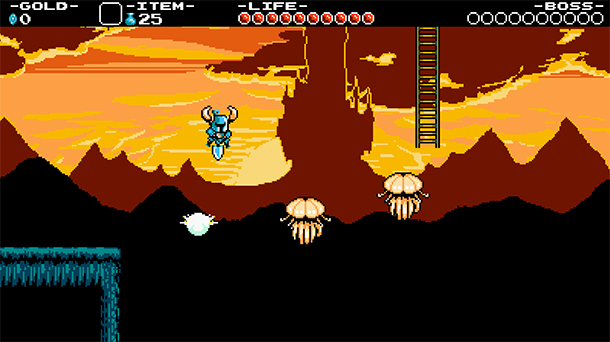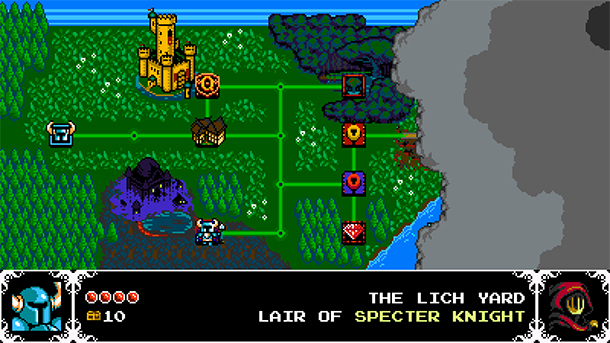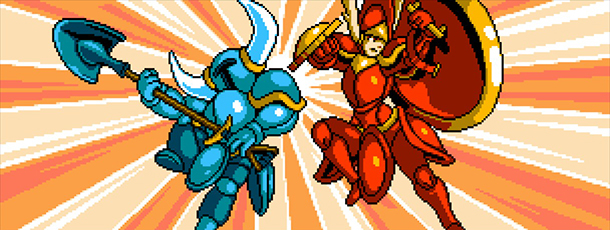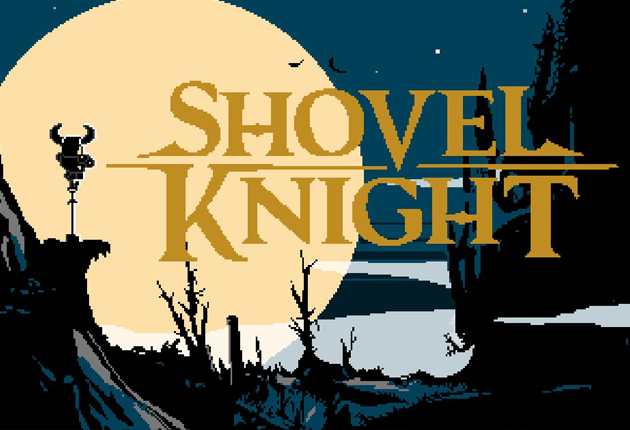We’ve been exposed to a deluge of retro-inspired platformers over the past few years. More often than not they feel like a half-hearted attempt to cash in on nostalgia catering to those children of the 8-bit era. Shovel Knight, the debut release from Yacht Club Games, isn’t like the rest. Instead it hearkens back to the halcyon days of when the Nintendo Entertainment System was king and all others were an afterthought.
As far as the story goes, Shovel Knight and Shield Knight have a long and storied history of protecting this realm, but the purity of the world they’ve fought so hard to protect is sullied by the emergence of The Enchantress and her minions, The Order of No Quarter. When Shovel Knight is separated from Shield Knight in battle, he is determined to rescue her at any cost.

You’ll rely on your shovel as your primary tool and weapon, using it to unearth treasure, destroy obstacles, bounce off objects and vanquish all in your path. Combat and traversal feels very Duck Tales-esque, especially when pogo jumping to bounce off obstacles and enemies. As you progress, you’ll unlock new gear that you’ll use to traverse the environment and integrate into the flow of combat.
As you traverse the ten dungeons you’ll collect a ton of loot that can then be exchanged in towns for health and mana upgrades, new sets of armor with special bonuses as well as augmenting Shovel Knight’s abilities, such as adding the ability to fire a burst of energy with your shovel swings when at full health, Zelda-style. You can also use your vast riches to purchase any of the relics from completed dungeons that you may not have found during your run through.
The towns themselves are bustling with a slew of NPCs going about their business, and the majority of them are just chock full of character and well-written, giving a whole bunch of fun background information to flesh out the world they’ve created.
Even after unlocking each level’s relic, though, there isn’t really anything that allows you to just hang back and take out enemies from afar. Instead, you’re constantly in the thick of it, getting up close and personal with your enemies. The same is true for taking out obstacles and dealing with the more complex platforming sequences. Swapping between relics and your shovel, bouncing throughout combat becomes essential for survival, and understanding the arc, physics and limitations of your jumps, dashes and attacks becomes increasingly important as you get inch ever closer to the Enchantress’ lair and uncover the world’s secrets.
Discovering the game’s secrets are half of the fun, and they’re all over the place. Many of them are inaccessible without first destroying walls or other parts of the world, which makes you examine the environment a lot more than you would had you just been blazing a trail to the end of the level so you can find that destructible terrain.
I’m admittedly terrible at 2D platformers in recent years. I’ve never gotten past the second robot master in any Mega Man game, and was could never successfully implement Scrooge’s pogo jump in Duck Tales. I was, however, able to have a fantastic time with Shovel Knight, conquering the game’s ten dungeons, all optional challenge levels, boss encounters and beginning a new game plus run in around six hours time.
A major part of what made my experience so enjoyable was that the game is checkpointed extremely well. It does a great job at consistently having you make it through just enough screens that you begin to sweat it before rewarding you with a checkpoint. For those more hardcore than I, however, the checkpoints can also be destroyed with your shovel in exchange for more loot.That’s not to say it was easy by any means. There were more than a few occasions when I just tossed the controller on my desk and had to walk away, but when I failed, I knew it was my fault, and had to tighten up my play style, which made succeeding several attempts later incredibly satisfying.

The controls just feel right. They’re tight, responsive, and always did what just what I want them to do with no exceptions.When I was playing, Shovel Knight always landed exactly where I told him to. I know it sounds strange, saying controls did what they were supposed to do, but it really is important, and I don’t think the game would be anywhere near as good as it is had there been any control issues. It reminded me a lot of playing Super Meat Boy. They’re both difficult, for sure, but when you died, it was your own damn fault. I can respect that beautiful simplicity more than I can floaty or inaccurate controls in a game based solely on precision platforming.
There’s no doubt in my mind that a large contingent of those into this style of game appreciate the harsh difficulty spikes and that lack of checkpointing, and that they may ultimately be disappointed by the lack of challenge posed here.
Shovel Knight is unapologetically reverent to the 8-bit platformers of old, but doesn’t suffer from it. Rather than be beholden to those 8-bit restrictions and sensibilities that have held back so many retro-styled platformers, it harnesses what made those games great and hones them into a fresh experience.
It may come as no surprise, but I absolutely adore Shovel Knight. It’s a clever, thoughtful, well-made and extremely fun experience that serves as a sincere love letter to an era long since passed, and it heavily draws inspiration from some of the best games of the NES era to make something new and exciting. I’d argue it’s one of the better releases to come out this year, and if you give it a chance, I’m sure you’ll fall in love with it too.
This review is based on a retail copy of the game purchased through GOG on PC.



No Comments